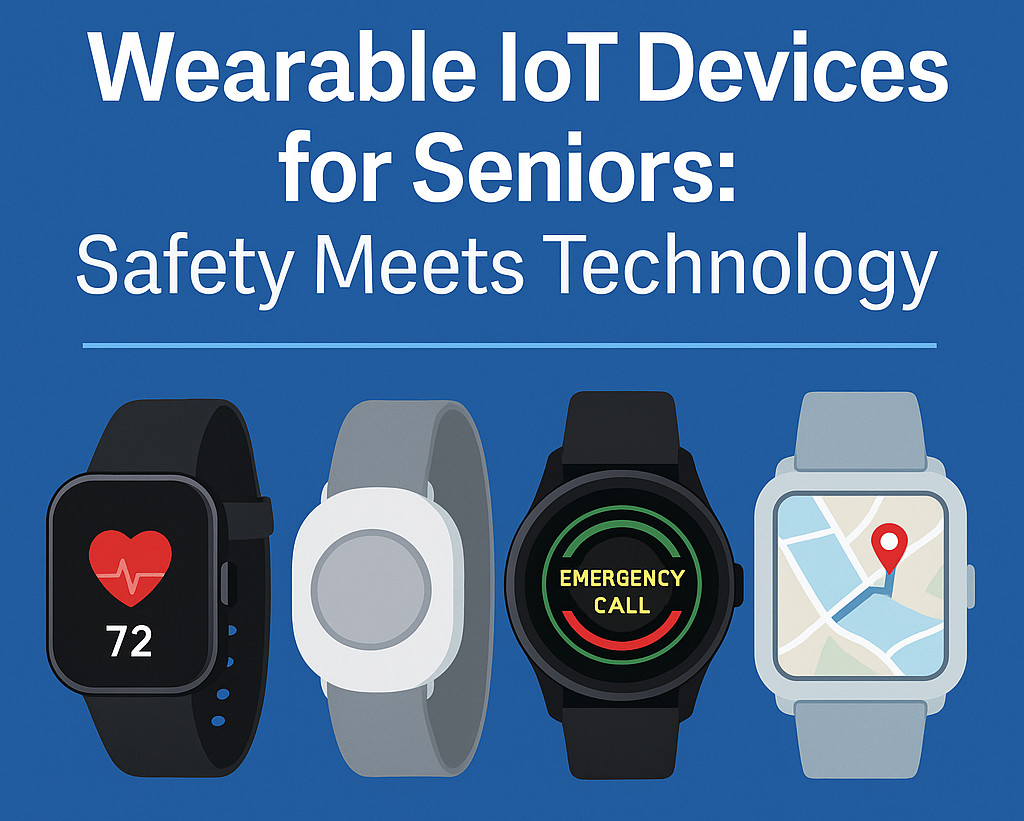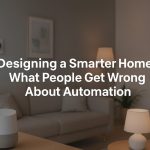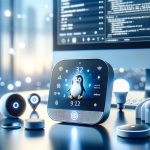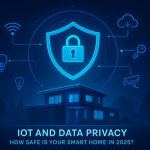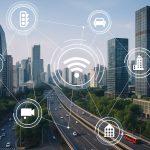In a world where technology evolves faster than ever, wearable IoT (Internet of Things) devices are emerging as life-changing tools—especially for seniors. These devices are no longer just fancy pedometers or step counters. They’re becoming essential tools for enhancing safety, independence, and health monitoring for the elderly.
This article dives into the best wearable IoT devices for seniors in 2025, exploring their features, real-world applications, and how they’re transforming elder care.
What Are Wearable IoT Devices for Seniors?
Wearable IoT devices are smart gadgets equipped with sensors and internet connectivity, designed to collect and transmit data. When tailored for seniors, these devices prioritize health tracking, emergency alerts, and location monitoring, offering both peace of mind for families and freedom for the users.
Top 5 Wearable IoT Devices for Seniors in 2025
1. Apple Watch Series 9 (Senior Mode)
Best for: Overall functionality and integration with health systems
Apple continues to dominate with its Series 9, now featuring a dedicated “Senior Mode.” Key features include:
- Fall detection & automatic SOS
- ECG and heart rate monitoring
- Medication reminders
- Voice-to-text assistant for accessibility
Pros: Seamless integration with iPhones, accurate sensors
Cons: Expensive, requires tech-savvy setup
2. Medical Guardian MGMove Watch
Best for: Emergency assistance & simplicity
This device is designed specifically for elderly users. It offers:
- 24/7 emergency monitoring
- GPS tracking and location sharing
- Step counting and simple fitness tracking
- Medication alerts
Pros: Easy to use, great customer service
Cons: Monthly subscription required
3. WellBe Medical Alert Smartwatch
Best for: Health-focused seniors
The WellBe Watch doubles as a health assistant and safety monitor. Features include:
- Heart rate tracking
- Blood oxygen monitoring
- Pedometer
- Emergency call button connected to a monitoring service
Pros: Lightweight and senior-friendly interface
Cons: Limited app support
4. AngelSense GPS Wearable
Best for: Seniors with cognitive challenges
Originally developed for children with autism, AngelSense is now widely adopted by caregivers of seniors with dementia. It offers:
- Real-time GPS tracking with route playback
- Auto pickup mode for easy calling
- Safe zone alerts and daily route updates
Pros: Excellent for safety and caregiver monitoring
Cons: Bulky design, requires smartphone for full features
5. CarePredict Tempo Series 3
Best for: Proactive health and behavioral tracking
This device does more than just send alerts—it learns routines and flags abnormal patterns. Highlights include:
- AI-driven behavior analysis
- Location and activity tracking
- Two-way voice communication
Pros: Predictive capabilities, caregiver dashboard
Cons: Best used within care facilities or monitored environments
Why These Devices Matter
Seniors today are living longer, more independent lives. But with independence comes the need for accessible safety. Wearable IoT devices bridge that gap:
- Preventive Care: Catch health anomalies early
- Emergency Response: Immediate alerts during falls or health events
- Peace of Mind: Reassurance for both users and their families
Choosing the Right Device
When selecting a wearable IoT device for an elderly loved one, consider:
- Ease of use: Is the interface intuitive?
- Battery life: Will it last through the day or night?
- Connectivity: Does it require Wi-Fi or mobile data?
- Subscription costs: Are there monthly fees?
- Design: Is it comfortable and discreet?
Frequently Asked Questions (FAQs)
Q: Are wearable IoT devices for seniors hard to use?
A: Not at all. Most are designed with large icons, simple menus, and voice assistance. Many brands now offer senior-specific models with minimal setup.
Q: Do these devices require a smartphone?
A: Some do, particularly those with advanced app features. Others can function independently, especially those meant for safety tracking.
Q: Are these devices covered by insurance or Medicare?
A: Some health plans or Medicare Advantage programs may partially cover medical alert systems, but it depends on the provider and the specific product.
Q: How secure is the data on these devices?
A: Leading manufacturers encrypt health and location data. However, users should review privacy settings and understand who can access the information.
Q: Can they detect falls or medical emergencies?
A: Yes. Most modern wearable IoT devices for seniors include fall detection and emergency alert buttons.
- Designing a Smarter Home in 2026: What People Get Wrong About Automation
 Smart homes were once science fiction, but today they’re a reality in millions of households. With voice assistants, smart plugs, and automated lighting systems, it’s easy to assume home automation is simply a matter of plugging in a few devices. Yet, many homeowners quickly discover that “smart” doesn’t always mean simple. In this article, we’ll…
Smart homes were once science fiction, but today they’re a reality in millions of households. With voice assistants, smart plugs, and automated lighting systems, it’s easy to assume home automation is simply a matter of plugging in a few devices. Yet, many homeowners quickly discover that “smart” doesn’t always mean simple. In this article, we’ll… - Automated Online Trading: How IoT is Redefining Financial Markets
 Introduction automated online trading In a world where milliseconds can decide millions, the fusion of Internet of Things (IoT) technology and automated online trading is reshaping global finance. What once relied solely on human judgment now increasingly depends on connected machines, real-time data, and predictive algorithms. From weather sensors influencing agricultural trades to smart logistics…
Introduction automated online trading In a world where milliseconds can decide millions, the fusion of Internet of Things (IoT) technology and automated online trading is reshaping global finance. What once relied solely on human judgment now increasingly depends on connected machines, real-time data, and predictive algorithms. From weather sensors influencing agricultural trades to smart logistics… - The Role of Linux in IoT: Powering the Connected World
 The Internet of Things (IoT) is everywhere—from smart homes and wearable devices to industrial automation and self-driving cars. Behind the scenes, one operating system plays a surprisingly dominant role: Linux. Known for its stability, flexibility, and open-source nature, Linux has become the backbone of countless IoT devices and platforms. But what makes Linux so well-suited…
The Internet of Things (IoT) is everywhere—from smart homes and wearable devices to industrial automation and self-driving cars. Behind the scenes, one operating system plays a surprisingly dominant role: Linux. Known for its stability, flexibility, and open-source nature, Linux has become the backbone of countless IoT devices and platforms. But what makes Linux so well-suited… - The Smart Home Revolution in 2025: How IoT is Transforming Everyday Living
 In the past decade, the vision of a truly smart home has moved from futuristic fantasy to everyday reality. As we step into 2025, the Internet of Things (IoT) has matured into a robust ecosystem, connecting appliances, security systems, lighting, and even entertainment devices under one seamless digital roof. The result? Homes that are safer,…
In the past decade, the vision of a truly smart home has moved from futuristic fantasy to everyday reality. As we step into 2025, the Internet of Things (IoT) has matured into a robust ecosystem, connecting appliances, security systems, lighting, and even entertainment devices under one seamless digital roof. The result? Homes that are safer,… - IoT and Data Privacy: How Safe Is Your Smart Home in 2025? – IoT Security
 The smart home revolution has made everyday life more convenient than ever. From voice assistants that control the lights to security cameras that send alerts directly to your phone, connected devices have become part of our daily routines. But with this convenience comes an important question: how safe is your personal data in a world…
The smart home revolution has made everyday life more convenient than ever. From voice assistants that control the lights to security cameras that send alerts directly to your phone, connected devices have become part of our daily routines. But with this convenience comes an important question: how safe is your personal data in a world…

